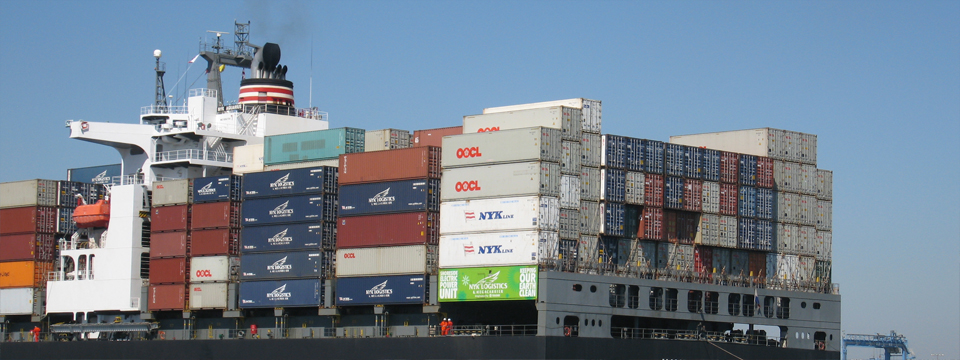
Webpage Links: Previous Vessel Speed Reduction (VSR) Programs | Local Studies & Actions | Initiatives | 2007 Retrofit Project
International Action
In 1973, an international conference of the IMO adopted the International Convention for the Prevention of Marine Pollution from Ships (MARPOL), and an accompanying treaty (these treaties are termed “Annexes”) designed to prevent pollution from ships.
In 1997, the IMO agreed to MARPOL Annex VI, a global treaty to reduce air emissions from ships. The treaty was to become effective one year after being ratified by at least fifteen nations, representing a minimum of fifty percent of the world’s shipping tonnage. On May 18, 2004, MARPOL Annex VI was ratified by the fifteenth nation, bringing the total percent of the world’s merchant shipping tonnage to 54.57%. Annex VI went into effect on May 19, 2005. The U.S. ratified MARPOL Annex VI in 2008.
MARPOL Annex VI:
- Sets limits on sulfur dioxide (SOx) and NOx emissions from ships, and prohibits the intentional emission of ozone-depleting substances such as chlorofluorocarbons.
- Sets a global limit on the maximum allowable sulfur content of fuel oil used in shipping to 4.5% m/m, and call for the IMO to monitor the worldwide average sulfur content of shipping fuel.
- Establishes specific “SOx Emission Control Areas” with more stringent controls on SOx emissions (1.5% m/m).
- Prohibits on-board incineration for ships carrying certain products.
North American Emission Control Area
 On March 30, 2009, the EPA announced that the U.S. would ask the IMO to create a North American Emission Control Area (ECA). On March 26, 2010, the IMO officially designated the North American ECA, as depicted on the map. Stricter fuel and engine standards apply in waters up to 200 nautical miles from the coasts of the United States, Canada and the French territories. Beginning in 2015, the fuel sulfur limit was lowered to 0.1 % in the ECA.
On March 30, 2009, the EPA announced that the U.S. would ask the IMO to create a North American Emission Control Area (ECA). On March 26, 2010, the IMO officially designated the North American ECA, as depicted on the map. Stricter fuel and engine standards apply in waters up to 200 nautical miles from the coasts of the United States, Canada and the French territories. Beginning in 2015, the fuel sulfur limit was lowered to 0.1 % in the ECA.
State Action
In July of 2009, a CARB rule required the use of lower-sulfur fuel when within 24 nautical miles of the California coast took effect. Due to the increased costs of the highly-refined fuels, some ship operators chose to travel outside of the Santa Barbara Channel.
In 2011, a study was published that documented the emissions benefits from the fuel rule. A National Oceanic and Atmospheric Administration (NOAA) plane flew over a Maersk container ship in the Santa Barbara Channel and measured emissions from the ship’s stack before and after the switch to the lower-sulfur fuel and a reduction in speed. Emissions of sulfur dioxide and particulate were reduced by 90%, and significant reductions in air toxics and black carbon were also achieved. The study did not measure NOx emissions, but NOx was estimated to be reduced by 5-7%.
As the fuel rules started applying to vessels within 200 nautical miles of the California coast (Beginning in 2012, with increased stringency in 2015), most ships have returned to the inside-the-Channel route.
U.S. Coast Guard
The U.S. Coast Guard initiated a Port Access Route Study in April of 2010, when ships began traveling outside the Santa Barbara Channel, where there are no internationally-designated shipping lanes. Ship operators were taking this action to avoid requirements of the California Air Resources Board’s rule, which required them to use a lower-sulfur fuel when within 24 nautical miles of the California coast.
The Port Access Route Study was issued in September of 2011. The Study recommended moving the established shipping lanes in the Santa Barbara Channel closer together for better protection of the Channel Islands Marine Sanctuary. The Study also recommended establishing another set of shipping lanes outside the Channel Islands. Since the Study was issued, the Coast Guard finalized the process of moving the shipping lanes closer together, but has not pursued establishing shipping lanes outside the Islands.
On July 6, 2012, the International Maritime Organization (IMO) Safety of Navigation Sub-Committee approved the U.S. proposal to adjust the traffic separation schemes in the Santa Barbara Channel, moving the southbound lane one mile further away from an area within the sanctuary known to be a seasonal feeding ground for endangered blue whales.
Rules Timeline
See chart below for overview of time frame for rules taking effect.

Other Marine Shipping Links
California Air Resources Board (CARB)
- Ocean-Going Vessels – Fuel Rule
- Goods Movement Action Plan, a joint effort by CARB, the California Business Transportation & Housing Agency and the California Environmental Protection Agency
- CARB Maritime Air Quality Technical Working Group
U.S. Environmental Protection Agency (EPA)
- Ocean Vessels and Large Ships – Federal rules and links to international actions
Major California Ports
- Port of Los Angeles
- Port of Long Beach
- Port of Hueneme
- Port of Oakland
- Port of San Francisco
- Port of San Diego
Other Links
- European Commission on Transport and the Environment
- International Maritime Organization (IMO)
- MARAD (U.S. Department of Transportation Maritime Administration)
- Sustainable Shipping / BunkerWorld – News on marine transportation related environmental topics
Note: listing of outside links and information resources here should not be seen as an endorsement of the information by the District.

